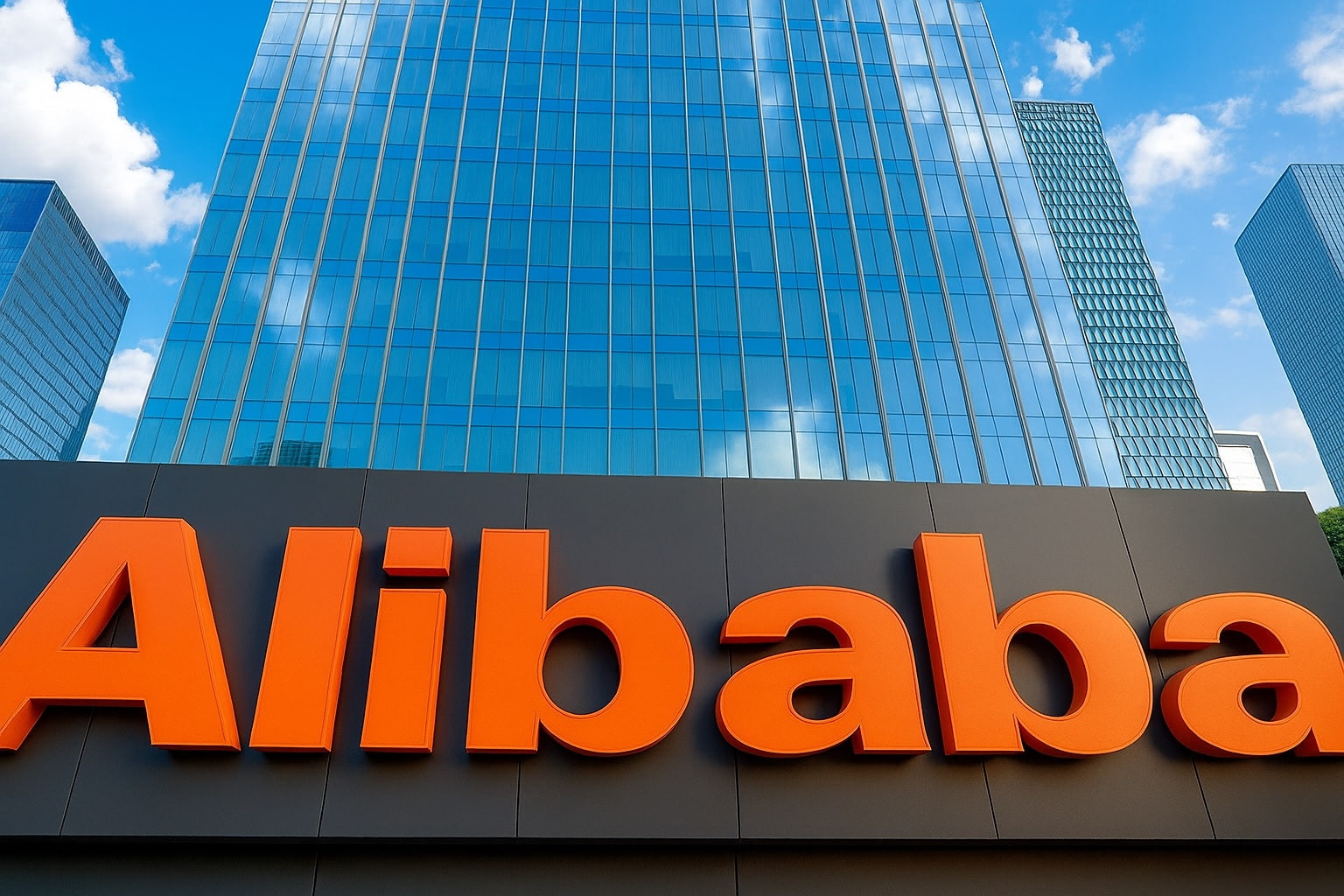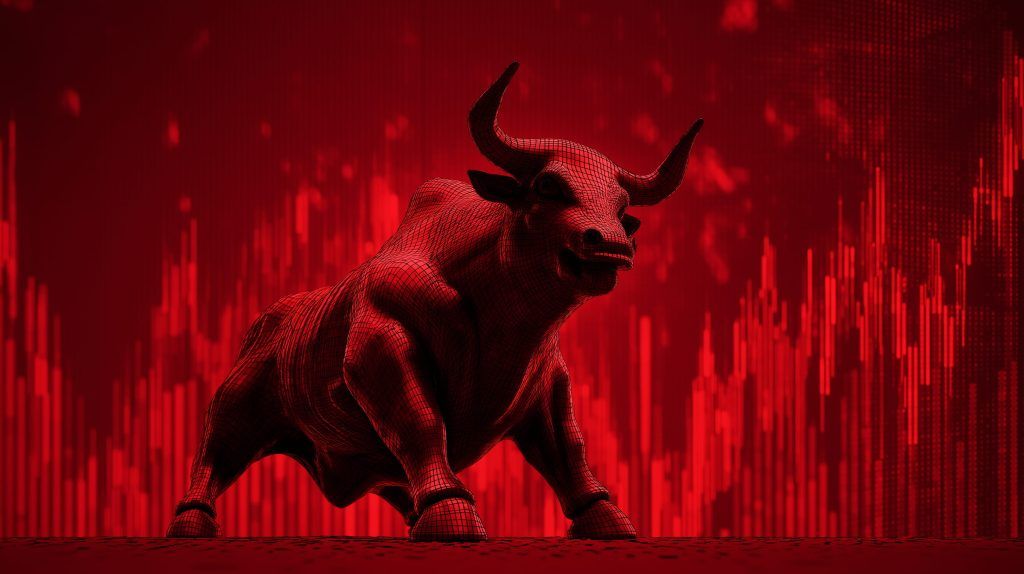Updated: November 15, 2025 – For informational and educational purposes only. Not financial advice.
Key Takeaways
- BABA trades around $153–154 per share in New York today, after a sharp pullback on fresh U.S. national‑security allegations. That’s still up roughly 80–90% over the past year. [1]
- November 2025 is a critical month: Alibaba reports its September‑quarter (fiscal Q2 2026) results around November 25, with analysts expecting only low single‑digit revenue growth but a steep year‑on‑year drop in profit as AI and cloud investments surge. [2]
- AI and cloud are now the core of the Alibaba story: the group has pledged tens of billions of dollars in cloud and AI spend over three years and is launching products from trillion‑parameter Qwen models to AI glasses, chatbots and B2B “AI Mode”, while aggressively cutting model prices amid a Chinese AI price war. [3]
- Geopolitical and legal risks just escalated: a White House memo reported by the Financial Times and Reuters accuses Alibaba of providing technological support to China’s military, triggering a stock drop and a fresh securities‑class‑action investigation from Rosen Law Firm. [4]
- Wall Street is still broadly bullish but divided: major aggregators show a 12‑month average price target around $187–$190 (roughly 22–24% upside) with a “Strong Buy” consensus — even as at least one AI‑driven model has downgraded BABA to “Hold”. [5]
Where Alibaba (BABA) Stock Stands Today
As of today, November 15, 2025, Alibaba Group Holding Ltd. (NYSE: BABA) trades around $153.8 per share in U.S. trading, with intraday moves amplified by the latest geopolitical headlines.
Over the past year, BABA has staged a remarkable comeback, with 12‑month gains of roughly 80%+, and some estimates putting its 2025 year‑to‑date rally close to 90%, vastly outperforming many Chinese peers. [6]
On fundamentals:
- Trailing 12‑month EPS is about $8.60, implying a trailing P/E near 18x at the current price. [7]
- Consensus forecasts see EPS rising to about $9.3 next year, putting forward P/E in the mid‑teens (~16–17x) — a discount to many U.S. megacap tech names but a premium to some domestic Chinese internet peers. [8]
Across major tracking sites, 12‑month analyst targets cluster around $187–$190, with highs near $240 and lows in the mid‑$130s. That implies ~22–24% upside from today’s level if the consensus is right — but also underlines a wide spread of views on risk. [9]
November 2025: A Pivotal Month for BABA
1. Earnings Countdown: Q2 2026 (September Quarter) in Focus
Alibaba is scheduled to release its September‑quarter 2025 results (fiscal Q2 2026) around November 25, 2025, according to its own investor‑relations guidance and multiple earnings calendars. [10]
Pre‑earnings previews suggest:
- Revenue forecast: around CNY 242–244 billion, up only ~2–3% year‑on‑year. [11]
- Pre‑tax profit expected down nearly 65% YoY, as the company leans into cloud infrastructure, AI models and instant commerce subsidies. [12]
- EPS projected around CNY 5.5, versus CNY 15.1 a year ago — a reminder that heavy AI spending and price competition are compressing near‑term earnings. [13]
Investors will likely focus less on whether Alibaba “beats” consensus and more on:
- Growth in Cloud & AI revenue, which has been running in the high‑teens to mid‑20% range, with AI‑related product revenues growing at triple‑digit rates. [14]
- Traction in international commerce, where revenue has recently grown faster than the domestic core. [15]
- The impact of AI and instant‑commerce investment on margins and free cash flow. [16]
2. Singles’ Day 2025: Solid Volumes, Slower Growth
China’s Singles’ Day 2025 festival — traditionally Alibaba’s showcase event — delivered GMV of nearly CNY 1.7 trillion (≈$238–240 billion) across major platforms, up around 17–18% from last year. [17]
But growth slowed sharply from the roughly 26–27% expansion seen in 2024, reflecting:
- A weaker consumer backdrop: a slumping property market, stagnant wages and high youth unemployment in China. [18]
- A more mature promotion landscape, with discounts stretched across weeks instead of one explosive 24‑hour window. [19]
Alibaba did not publish headline GMV figures for Tmall/Taobao but highlighted strong performance from key merchants and a broader push overseas, with Taobao‑branded Singles’ Day campaigns in over 20 countries and AliExpress‑driven events in cities like London. [20]
For BABA shareholders, the takeaway is nuanced:
- Core commerce is stable but no longer hyper‑growth.
- Internationalisation and AI‑driven engagement (e.g., live shopping, personalised feeds) are increasingly important to the story. [21]
AI, Cloud and Tokenized Payments: New Growth Engines
1. Massive AI and Cloud Investment
In 2025 Alibaba has doubled down on being an “AI‑driven, user‑first” company, with management pledging aggressive cloud and AI investment over the next three years — reportedly on the order of tens of billions of dollars, and more than it spent in the previous decade. [22]
Recent quarters already show the impact:
- Revenue in the December 2024 / early 2025 quarter grew about 7–8% year‑on‑year to roughly CNY 280 billion, with cloud up ~13% and international commerce up over 30%. [23]
- FY2025 results show overall revenue up ~6% to nearly RMB 1 trillion, with domestic customer‑management revenue up 12% and cloud growth accelerating to 18%. AI products notched their seventh straight quarter of triple‑digit growth. [24]
2. Product Pipeline: Qwen Models, Chatbots and AI Glasses
Alibaba’s AI roadmap is increasingly tangible:
- Qwen LLM family and Qwen3‑Max: its flagship trillion‑parameter model saw price cuts of up to 50% this week, slashing per‑token rates and intensifying China’s AI price war. [25]
- Quark AI chatbot: launched in October 2025 as a free assistant inside the Quark app, powered by Qwen3 models — a renewed push into consumer AI after earlier Tongyi apps underwhelmed. [26]
- Quark AI Glasses: lightweight smart glasses priced around 4,699 yuan (~$660), offering real‑time translation, meeting transcription and hands‑free media, with presales tied to Singles’ Day. [27]
- Rebranding its AI apps to “Qwen” and integrating “agentic” AI capabilities directly into Taobao shopping experiences, positioning Alibaba as a direct competitor to ChatGPT‑style assistants in commerce. [28]
At the B2B level:
- Alibaba.com’s “AI Mode” and deep search are being embedded into the global wholesale marketplace, which recently reported a 57% surge in European orders and a 50% increase in worldwide supplier growth, partly attributed to AI tools. [29]
- The company is preparing an AI‑powered B2B subscription offering, signalling an ambition to monetise AI directly rather than only via cloud usage. [30]
3. Tokenized Payments with JPMorgan
Another November headline: Alibaba is working with JPMorgan’s tokenisation technology on a stablecoin‑like, tokenised payment system for its roughly $35 billion commerce network, aiming to roll out a global payment network by December. The system uses tokenised fiat rather than a public crypto asset, targeting faster and cheaper cross‑border B2B flows. [31]
If regulators are comfortable with the structure, tokenised payments could:
- Reduce friction and foreign‑exchange costs for Alibaba’s merchants.
- Deepen the ecosystem “moat” across its B2B and cross‑border e‑commerce platforms.
But anything involving digital tokens and U.S. banks also adds a regulatory‑complexity layer to the investment case.
Restructuring Around “E‑Commerce + Cloud + AI”
Alibaba has not stopped at technology upgrades; it has also reshaped its organisation again in 2025.
After its 2023 “1+6+N” break‑up plan, the company simplified into four main groupings in August 2025:
- Alibaba China eCommerce Group – Taobao, Tmall, Xianyu, Fliggy and instant‑retail operations like Taobao Flash Purchase and food‑delivery app Ele.me.
- Alibaba International Digital Commerce Group – overseas marketplaces such as AliExpress and Lazada.
- Cloud Intelligence Group – Alibaba Cloud and AI services.
- “All Other” businesses – DingTalk, Quark, AutoNavi, Cainiao, Youku, Hema, Ali Health and others.
Management has framed this as a “contraction and focus” strategy: compressing from six divisions to a tighter portfolio, concentrating resources on e‑commerce plus cloud + AI, and aiming for every business to be “AI‑driven” over the next three to five years.
For investors, this matters because:
- It clarifies which units are core value drivers (China e‑commerce and Cloud) and which are candidates for partnerships, partial monetisation or de‑prioritisation over time.
- It supports the “sum‑of‑the‑parts” thesis many analysts use when arguing that Alibaba remains undervalued versus the combined worth of its businesses.
Competition, Consumption and the China Macro Backdrop
Alibaba’s opportunity is large — but so is the competitive and macroeconomic pressure.
- In instant commerce, Alibaba is investing about $281 million to convert local convenience stores into Taobao‑branded, AI‑enabled mini‑hubs capable of 30‑minute delivery, going head‑to‑head with Meituan in a market expected to reach CNY 2 trillion (~$280 billion).
- Daily order volume for Taobao Flash Purchase plus Ele.me reportedly exceeded 90 million, with over 200 million daily active users, underscoring the scale but also the cost of competing in food delivery and instant retail.
Alibaba’s deep cash reserves and strong cash generation give it more room than smaller rivals to subsidise users and merchants. Some analysts even recommend long‑Alibaba / short‑Meituan strategies on that basis.
At the same time:
- China’s consumer recovery remains uneven and cautious, as reflected in Singles’ Day’s slower growth and commentary on weaker household balance sheets.
- JD.com’s latest results highlight how price wars in food delivery and budget e‑commerce have already slashed margins across the sector.
This mix suggests that top‑line growth is achievable, but margin expansion is harder unless AI and cloud scale fast enough to offset subsidy‑heavy commerce segments.
Geopolitical and Legal Risks Just Spiked
The most market‑moving headline this week has nothing to do with AI models or Singles’ Day.
1. White House Memo Allegations
On November 14–15, multiple outlets reported on a White House national‑security memo alleging that Alibaba provides technological support to China’s People’s Liberation Army for operations targeting the United States, citing declassified “top secret” intelligence.
Key points:
- The memo, described by the Financial Times and relayed by Reuters, does not specify the exact technologies or use‑cases, nor any concrete U.S. response such as sanctions or procurement bans.
- Alibaba has strongly denied the allegations, calling them baseless and questioning the motives behind the leak. Chinese officials have similarly rejected the claims.
- BABA’s U.S.‑listed shares dropped around 4% intraday on the news.
For investors, this revives a familiar worry: could U.S.–China tensions lead to new restrictions, fines, sanctions, added export‑control scrutiny or pressure on U.S. capital‑market access? There is no such action announced yet — but the memo raises the probability of policy surprises over the next 12–24 months.
2. Securities‑Class‑Action Investigation
Within hours of the Reuters report, Rosen Law Firm announced an investigation into potential securities claims on behalf of Alibaba shareholders, alleging the company may have issued “materially misleading” business information. The firm is soliciting investors for a possible class action.
These law‑firm notices are relatively common after sharp stock moves and do not automatically imply wrongdoing. However, they:
- Add to headline risk around the stock.
- Increase the chance of multi‑year litigation costs and settlements, especially if U.S. regulators decide to scrutinise the underlying national‑security allegations more closely.
What Wall Street and Big Money Are Saying
Despite the fresh risks, sell‑side coverage remains broadly positive:
- One major forecast service reports an average 12‑month price target of about $190, with a high of $240 and a low around $152, implying ~24% upside from the previous close.
- Another aggregator shows 13 analysts with an average target near $187 and a “Strong Buy” consensus; the range runs from $135 to $240, suggesting both upside optionality and non‑trivial downside views.
- Research notes from banks like UBS and Mizuho have lifted price targets this year (e.g., to $195–$216) on the back of stronger‑than‑expected cloud growth, an improved margin trajectory and the potential of Alibaba’s AI and robotaxi partnerships.
At the same time:
- An AI‑driven analyst model on TipRanks downgraded Alibaba to “Hold” this week, trimming its price target despite overall Wall Street optimism, citing concerns over the balance between heavy AI spending and geopolitical risk.
- The Antipodes Global Value Strategy — a respected value‑oriented fund — describes Alibaba as a key AI beneficiary in China with cloud infrastructure growing 25–30% annually, but warns that 2026 profits may dip as instant‑retail investment ramps, before earnings compound at ~20% per year thereafter in their base case.
Overall, institutional investors are treating BABA as:
- A high‑beta, high‑conviction AI and cloud play within China,
- With meaningful geopolitical and regulatory optionality — both to the upside (if tensions ease) and downside (if sanctions or harsher controls emerge).
BABA Stock Forecast: Scenarios into 2026
Because the near‑term outlook is unusually dependent on politics as well as fundamentals, it’s more realistic to think in scenarios rather than single‑number targets. The ranges below are illustrative, not guarantees or personal recommendations.
All scenario ranges are referenced against today’s price around $154.
Base Case (Probability: “Moderate”)
Cloud & AI deliver, but at a cost
Assumptions:
- China’s economy muddles through: household spending improves slowly, but no dramatic stimulus or meltdown.
- Core China e‑commerce grows low‑to‑mid single digits; international commerce grows high single digits to low teens.
- Cloud continues to grow 20–25% annually; AI‑related revenues maintain strong double‑digit or triple‑digit growth, but price cuts like Qwen3‑Max’s 50% reduction cap margin expansion.
- No major U.S. sanctions or forced divestments; the White House memo remains a background risk, not an active policy driver.
In this scenario, consensus 2026 EPS in the $9–10 range looks achievable, and the market may be willing to pay ~18–20x forward earnings for a structurally important AI/cloud leader still trading at a discount to U.S. peers.
- Illustrative 12–18 month valuation band:
- Low end: 9 × 18 = $162
- High end: 10 × 20 = $200
This roughly lines up with today’s Street consensus around the high‑$180s to low‑$190s.
Bull Case (Probability: “Lower but plausible”)
AI super‑cycle + easing geopolitics
Assumptions:
- Alibaba’s AI stack (Qwen models, AI Mode, Quark, AI Glasses, tokenised payments) gains meaningful market share domestically and in international B2B, boosting cloud utilisation and high‑margin software income.
- Singles’ Day 2026 and broader Chinese consumption surprise to the upside, stabilising e‑commerce share and reinforcing Alibaba’s “national champion” status in retail and payments.
- U.S.–China tensions do not escalate into direct sanctions on Alibaba; capital markets remain open, and the White House memo fades into the background amid successful rebuttals and diplomatic manoeuvring.
In this upside case, investors could be willing to value BABA more like a global AI platform, with a forward multiple in the low‑20s on EPS in the $10–11 region.
- Illustrative 12–18 month band:
- Low end: 10 × 22 = $220
- High end: 11 × 24 = $264
Street high targets around $240 sit comfortably inside this zone.
Bear Case (Probability: “Non‑trivial”)
Policy shock or AI price war hits margins harder
Assumptions:
- The White House memo leads to concrete actions: procurement bans, tighter export controls, or pressure on U.S. investors’ exposure to Alibaba, even without full sanctions.
- China’s consumer recovery underwhelms; Singles’ Day 2026 growth remains muted, and competition from JD.com, Pinduoduo and Meituan forces Alibaba to maintain heavy subsidies in instant commerce and live shopping.
- The AI price war accelerates (e.g., further deep cuts beyond Qwen3‑Max’s 50% reduction), compressing cloud and AI margins for longer than expected.
- Legal overhang grows as class‑action investigations proceed and investors price in potential settlements and governance concessions.
In that environment, the market could decide BABA deserves only 10–12x earnings — the kind of multiple applied to more cyclical, politically exposed Chinese SOEs in the past — on EPS that might stagnate or even fall.
- Illustrative 12–18 month band:
- Low end: 9 × 10 = $90
- High end: 10 × 12 = $120
Street low targets around $135 suggest some analysts see a milder version of this scenario as a real possibility.
What to Watch Next If You Follow BABA
For readers tracking Alibaba into 2026, the most important signposts are:
- November 25 earnings
- Cloud & AI growth rates and margin trends.
- Any change in capex guidance for AI/data centres.
- Regulatory and geopolitical signals
- Whether the U.S. memo turns into concrete restrictions or remains an isolated leak.
- Evolution of China’s own tech and data‑security rules affecting cloud and tokenised payments.
- AI monetisation metrics
- Adoption of Qwen models, AI Mode and AI subscriptions.
- Uptake of Quark AI Glasses and consumer chatbots versus rivals from ByteDance, Tencent and others.
- Commerce and consumer health
- Singles’ Day and other major campaigns as real‑time read‑outs on Chinese household demand.
- Competitive dynamics in instant commerce and food delivery.
Final Word
Alibaba in late 2025 is a high‑conviction, high‑controversy stock:
- Structurally, it’s one of the clearest ways to play China’s AI and cloud build‑out plus domestic and cross‑border e‑commerce.
- Cyclically, it’s operating in a sluggish consumer environment and a brutally competitive commerce market.
- Politically, it sits at the intersection of U.S.–China strategic rivalry, making it vulnerable to policy shocks that are difficult to model.
Any decision to invest in BABA will depend on your risk tolerance, time horizon, and view on geopolitics as much as your view on AI or Chinese retail.
This article is not investment, tax or legal advice. Before making any investment decisions, consider speaking with a qualified financial adviser and doing your own detailed research.
References
1. finviz.com, 2. www.ig.com, 3. www.ft.com, 4. www.reuters.com, 5. www.marketbeat.com, 6. www.investopedia.com, 7. www.marketbeat.com, 8. www.marketbeat.com, 9. www.marketbeat.com, 10. investingnews.com, 11. www.ig.com, 12. www.ig.com, 13. www.ig.com, 14. simplywall.st, 15. apnews.com, 16. www.ig.com, 17. apnews.com, 18. apnews.com, 19. www.emarketer.com, 20. www.reuters.com, 21. www.reuters.com, 22. www.ft.com, 23. apnews.com, 24. simplywall.st, 25. finance.yahoo.com, 26. www.reuters.com, 27. www.barrons.com, 28. www.inkl.com, 29. www.prnewswire.com, 30. www.azernews.az, 31. finance.yahoo.com







